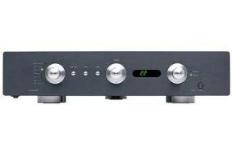What Hi-Fi? Verdict
Plenty of punch plus a warm yet informative sound
Pros
- +
Winning combination of power and poise
- +
impeccable build
Cons
- -
Works best with balanced inputs and connections
Why you can trust What Hi-Fi?
Sound apart, the great thing about Primare's components is that they look a lot more expensive than they are, even at this elevated level, thanks to solid, rigid casework and controls with a smoothness and precision that makes them a delight to use.
Inputs on this preamp are available both on standard phonos – three line-ins, a tape loop and an AV bypass – and two sets of balanced XLRs.
We'd suggest you use balanced wherever possible – running a reference player into the Pre30 balanced, then connecting out to Primare's A30.2 power amp in the same way. This brings extra focus and greater bass control.
The AV bypass is a useful facility for those of us seeking to combine a purist stereo system with surround sound: connect the front left/right channel preouts of a good AV receiver using this input, and the signal bypasses the preamp's switching and volume control, and goes straight through to the preamp outputs.
An impression of quality
Primare's C31 remote handset – a chunky metal-cased device, again with those precise buttons – controls the Pre30, and can also drive a range of the company's other products. The overall impression of quality is maintained before you even start to listen.
After a few hours' warm-up the preamp, (in harness with the A30.2 power amp) shows its not inconsiderable mettle. The balance is natural and controlled, but at the same time fully able to shake the walls when the recording and the ancillary equipment allows.
And there's all clarity needed to make the most of orchestral works, even when a symphonic big band is going full tilt at a spot of Mahler, or combining with a choir in a Verdi opera, or a Bach oratorio.
There's actually a dearth of amplifiers for this kind of money, and the Primare finds itself up against some serious rivals.
On this showing, however, the Pre30 – especially when used with the A30.2 power amp – has the ability to take on the best and shine through, with a sound that's rather more than just that of the company's integrated amps plus a dose of extra oomph.
What Hi-Fi?, founded in 1976, is the world's leading independent guide to buying and owning hi-fi and home entertainment products. Our comprehensive tests help you buy the very best for your money, with our advice sections giving you step-by-step information on how to get even more from your music and movies. Everything is tested by our dedicated team of in-house reviewers in our custom-built test rooms in London, Reading and Bath. Our coveted five-star rating and Awards are recognised all over the world as the ultimate seal of approval, so you can buy with absolute confidence.


